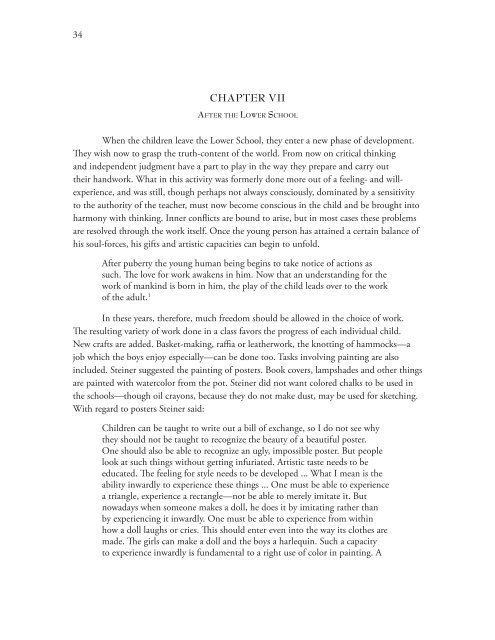Handwork and Handicrafts - Waldorf Research Institute
Handwork and Handicrafts - Waldorf Research Institute
Handwork and Handicrafts - Waldorf Research Institute
You also want an ePaper? Increase the reach of your titles
YUMPU automatically turns print PDFs into web optimized ePapers that Google loves.
34<br />
CHAPTER VII<br />
After the Lower School<br />
When the children leave the Lower School, they enter a new phase of development.<br />
They wish now to grasp the truth-content of the world. From now on critical thinking<br />
<strong>and</strong> independent judgment have a part to play in the way they prepare <strong>and</strong> carry out<br />
their h<strong>and</strong>work. What in this activity was formerly done more out of a feeling- <strong>and</strong> willexperience,<br />
<strong>and</strong> was still, though perhaps not always consciously, dominated by a sensitivity<br />
to the authority of the teacher, must now become conscious in the child <strong>and</strong> be brought into<br />
harmony with thinking. Inner conflicts are bound to arise, but in most cases these problems<br />
are resolved through the work itself. Once the young person has attained a certain balance of<br />
his soul-forces, his gifts <strong>and</strong> artistic capacities can begin to unfold.<br />
After puberty the young human being begins to take notice of actions as<br />
such. The love for work awakens in him. Now that an underst<strong>and</strong>ing for the<br />
work of mankind is born in him, the play of the child leads over to the work<br />
of the adult. 1<br />
In these years, therefore, much freedom should be allowed in the choice of work.<br />
The resulting variety of work done in a class favors the progress of each individual child.<br />
New crafts are added. Basket-making, raffia or leatherwork, the knotting of hammocks—a<br />
job which the boys enjoy especially—can be done too. Tasks involving painting are also<br />
included. Steiner suggested the painting of posters. Book covers, lampshades <strong>and</strong> other things<br />
are painted with watercolor from the pot. Steiner did not want colored chalks to be used in<br />
the schools—though oil crayons, because they do not make dust, may be used for sketching.<br />
With regard to posters Steiner said:<br />
Children can be taught to write out a bill of exchange, so I do not see why<br />
they should not be taught to recognize the beauty of a beautiful poster.<br />
One should also be able to recognize an ugly, impossible poster. But people<br />
look at such things without getting infuriated. Artistic taste needs to be<br />
educated. The feeling for style needs to be developed ... What I mean is the<br />
ability inwardly to experience these things ... One must be able to experience<br />
a triangle, experience a rectangle—not be able to merely imitate it. But<br />
nowadays when someone makes a doll, he does it by imitating rather than<br />
by experiencing it inwardly. One must be able to experience from within<br />
how a doll laughs or cries. This should enter even into the way its clothes are<br />
made. The girls can make a doll <strong>and</strong> the boys a harlequin. Such a capacity<br />
to experience inwardly is fundamental to a right use of color in painting. A

















